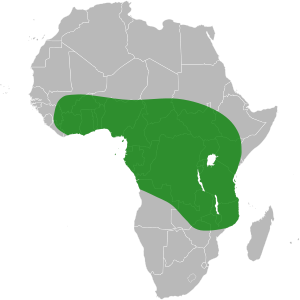Barth's rice facts for kids
Quick facts for kids Barth's rice |
|
|---|---|
| Scientific classification | |
| Genus: |
Oryza
|
| Species: |
barthii
|
 |
|
| The range of Oryza barthii. | |
| Synonyms | |
|
|
Oryza barthii, also called Barth's rice or African wild rice, is a type of grass. It belongs to the same plant family as the rice we eat. This wild rice grows every year and stands upright or slightly leaning.
It has special leaves with a small flap called a ligule, which is less than 13 millimeters long. Its flower clusters, called panicles, can be tight or spread out. They rarely have smaller branches. The seeds are found in large structures called spikelets, which are about 7.7 to 12.3 millimeters long and 2.3 to 3.5 millimeters wide. They have strong, usually red, bristles called awns that can be up to 20 centimeters long. The flowers also have small parts called anthers, which are about 1.5 to 3 millimeters long.
This wild rice grows in parts of Africa south of the Sahara Desert. You can find it in areas with mopane trees or open savanna grasslands. It also grows in fadama areas, which are lands that flood seasonally.
O. barthii likes to grow in deep water or land that floods often. It can also be found in still water or slow-moving streams and pools. It prefers clay soils or dark, rich soils called vertisols. This plant grows best in open, sunny places.
It is the wild ancestor of a type of cultivated rice called Oryza glaberrima, which is African rice.
Amazing Roots
Oryza barthii has special roots called nodal roots. These roots are home to tiny helpers called Bradyrhizobium. These helpers are a type of bacteria. They can do something amazing: they help the plant get nitrogen from the air. This process is called nitrogen fixation. Nitrogen is a very important nutrient for plants to grow.
Some of these bacteria can also perform photosynthesis. This means they can use sunlight to make their own food, just like plants do.
Its Genetic Code
Scientists have studied Oryza barthii very closely. In 2014, they fully mapped its genome. The genome is like a complete instruction manual for how the plant grows and works.
This species is part of a group called the AA species. This group includes both domesticated rices, like the ones we eat, and their wild relatives. Studying wild relatives like O. barthii helps scientists understand how cultivated rice developed. It can also help them find new traits for improving modern rice crops.
Where It Grows
O. barthii is mostly found in West Africa. It thrives in warm, wet environments. Its ability to grow in flooded areas makes it unique.

